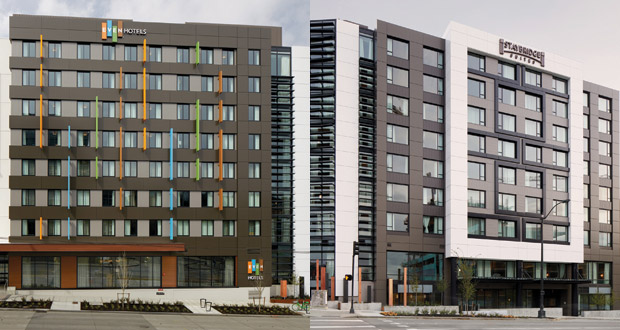
One of the most popular topics at lodging industry events is whether or not there are too many hotel brands out there. While some would argue that guests are suffering from decision fatigue and are overwhelmed by their options, that hasn’t stopped big hospitality companies from launching new brands and finding ways to revitalize old ones, rather than retire them.
Further, the wealth of brands in the hotel industry has led to the rise of another trend: dual-branded properties. The reasoning goes that these properties foster parent-brand loyalty and introduce travelers to brands and experiences they wouldn’t otherwise have been exposed to. They also can be quite cost-efficient, both from a development and operations perspective, leading franchisees and other investors to place their bets on two brands, rather than one.
Steven Nicholas, CHA, principal and executive vice president at Atlanta, Ga.-based Noble Investment Group, says that the benefits of having two brands has been driving development of these types of properties. “The market is doing well and people can build, so they’re going to. Having two brands in one property helps diversify its guest demographics and helps fill rooms, maximizing its potential,” he says. Nicholas has some first-hand experience in the dual-brand department—his company developed the EVEN Hotel/Staybridge Suites Seattle – South Lake Union. This 235-room property (123 EVEN rooms, 112 Staybridge) officially opened its doors in April and is in the heart of Seattle’s burgeoning technology district, home to offices for Google, Amazon, and many others. It’s also within walking distance of Seattle’s Lake Union, meaning that it sees its fair share of tourists as well.
Nicholas explains that Seattle’s growing business opportunities, as well as its unique culture, made it a natural fit for a dual-branded property. Once that was determined, the Staybridge and EVEN brands just felt like a natural next step. “Seattle has done a tremendous job attracting businesses, which made an extended-stay product essential. It also has a health-focused culture, which makes it a perfect city for EVEN, which, as a brand, is built on allowing travelers to maintain a healthy lifestyle when they’re on the road.”
But even when a dual-branded hotel makes sense, there are factors developers and operators need to keep in mind before executing such a property. Nicholas says that hoteliers should take care not to mix the brands too much, which can dilute the guest experience. “When people build a dual-branded property, they’re trying to work in all the efficiencies that they possibly can, but they also don’t want to muddle the brand experiences. Getting those two realities to work together can be a challenge,” he describes. In the Seattle EVEN/Staybridge property, Noble Investment Group circumvented this issue by creating two lobbies and clearly differentiated public and guestroom spaces. “People coming in for the EVEN experience want that full experience. Same for Staybridge. However, there are some areas that can be combined without causing too much disruption,” Nicholas explains. “In our case, the property has shared parking, meeting space, and a courtyard.”
Nicholas notes that having two brands also gives the property’s sales team an opportunity to achieve greater market penetration—if Staybridge isn’t what the client is looking for, maybe EVEN better strikes their fancy. “We can go into Amazon and say, ‘We know you have a group of interns coming who are going to be staying for more than 30 days—Staybridge is a great option for them. We also know that you have a training class coming for two days next week. Maybe they’ll appreciate the lifestyle touches that EVEN offers,’” he says.
Guests have also adapted well to the dual-branded model. Nicholas says that sometimes they encounter issues like an Uber driver dropping a guest at the wrong entrance, but the overall experience makes up for little blips like this. “These minor inconveniences can be smoothed over by a fantastic service culture,” he says.











